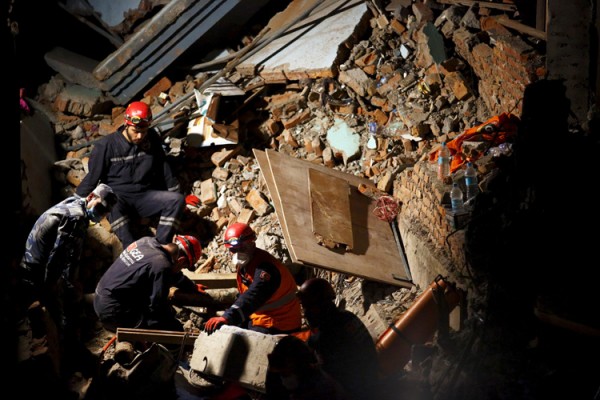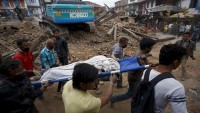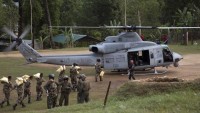Nepal Strives To Restore Phone And Internet Services To Reconnect To The World
| Cybelle Go | | May 13, 2015 11:13 PM EDT |
(Photo : REUTERS/Navesh Chitrakar) Rescue team member from Nepal, Turkey and china works during the rescue operation to rescue live victims trapped inside the collapsed hotel after an earthquake in Kathmandu, Nepal.
Nepal, struck again with a 7.3 magnitude earthquake last Tuesday, has been striving for rehabilitation of the devastation that killed more than 7,000 of its population.
The restoration of Nepal will probably take several years to achieve but telecommunications and web companies are now rushing to resume their operations for the benefit of the country to reconnect to the world, according to The Business Times.
Like Us on Facebook
The most essential aspect of any humanitarian response is the opportunity for rescue team and aid workers to have access to internet or phone lines in Nepal.
Phone lines will have a tendency to be congested in times of disaster, so the urgent action of restoring communication and providing an alternative in Nepal will serve as an advantage.
Telecommunication experts from various countries gathered in Kathmandu, Nepal last April to devise measures on how a phone network can respond to future disasters.
"Although we knew the risk for Kathmandu Valley was very high, we never expected it would be too soon," said Kyla Reid, head of disaster response in GSM Association.
The World Food Programme, a branch of United Nations that promotes food assistance, already launched their innovative kit on improving the means of communication for both residents and the rescue team.
The World Food Programme has collaborated with the Luxembourg government, Ericsson and the NGO company Nethope, in developing mobile antennas that are small enough to be portable on a commercial flight.
"They look like beach balls," said Mariko Hall, employee of World Food Programme.
Hall described the mobile data antennas as "inflatable, light and quick to deploy."
The mobile antenna mimics the function of a wifi network, providing an accessible internet connection in the most remote areas where signal is weak.
The rescue teams can gather and update data with this innovative technology, thus promoting a faster system particularly in logistics.
A member in the rescue team can now update locations in Nepal where extensive damage has occurred.
Despite the high magnitude of the two succeeding Nepal earthquakes, the phone network maintained its function, according to Henrik Westman, head of TeliaSonera, Nepal Telecom's sister company. Westman further added that 300 sites had problems after Tuesday's earthquake in Nepal but this was more related to power supply.
TagsNepal, Nepal Earthquake, earthquake survivors, phone lines
©2015 Chinatopix All rights reserved. Do not reproduce without permission
EDITOR'S PICKS
-

Did the Trump administration just announce plans for a trade war with ‘hostile’ China and Russia?
-

US Senate passes Taiwan travel bill slammed by China
-

As Yan Sihong’s family grieves, here are other Chinese students who went missing abroad. Some have never been found
-

Beijing blasts Western critics who ‘smear China’ with the term sharp power
-

China Envoy Seeks to Defuse Tensions With U.S. as a Trade War Brews
-

Singapore's Deputy PM Provides Bitcoin Vote of Confidence Amid China's Blanket Bans
-

China warns investors over risks in overseas virtual currency trading
-

Chinese government most trustworthy: survey
-

Kashima Antlers On Course For Back-To-Back Titles
MOST POPULAR
LATEST NEWS
Zhou Yongkang: China's Former Security Chief Sentenced to Life in Prison

China's former Chief of the Ministry of Public Security, Zhou Yongkang, has been given a life sentence after he was found guilty of abusing his office, bribery and deliberately ... Full Article
TRENDING STORY

China Pork Prices Expected to Stabilize As The Supplies Recover

Elephone P9000 Smartphone is now on Sale on Amazon India

There's a Big Chance Cliffhangers Won't Still Be Resolved When Grey's Anatomy Season 13 Returns

Supreme Court Ruled on Samsung vs Apple Dispute for Patent Infringement

Microsoft Surface Pro 5 Rumors and Release Date: What is the Latest?













